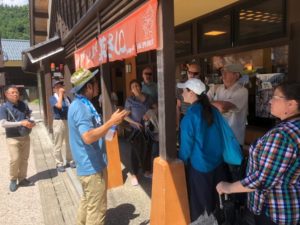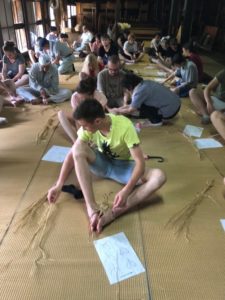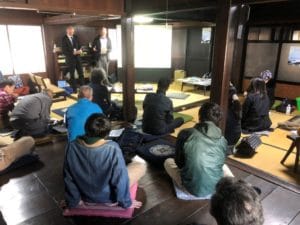
Field meeting among biosphere reserve participants from Japan, Russia, and Belarus (funded by the Japanese National Commission for UNESCO)
Written by Dr. Yoshihiko Iida, Research Associate at the United Nations University Institute for the Advanced Study of Sustainability, Operating Unit Ishikawa/Kanazawa, and Secretariat Advisor of the Mount Hakusan Biosphere Reserve Council.
Mountain landscapes contain a wealth of both nature and culture, and have the potential to be used for a broad range of educational activities in fields as wide-ranging as climatology, ecology, history, and the arts. What is more, the results of these educational activities, such as the scientific monitoring of water sources and the study of disaster responses, can also be applied to further sustainable community development.
With such an inclusive area for study then, what kind of human resource development program can be put in place by higher education sectors in mountains, beyond research? The UNESCO Biosphere Reserves provide an answer to this question.
Biosphere Reserve as Field Education Site
UNESCO launched the Man and Biosphere (MAB) program in 1971 in order to conserve biodiversity and support sustainable development. As a place of concrete practice, the MAB program encompasses a World Network of Biosphere Reserves. Currently, it has 686 sites in 122 countries.
Biosphere reserves have three interconnected functions: protecting bio- and cultural diversity, fostering economic and human development, and serving as a site for environmental education, training, and research. Three zones are defined in biosphere reserves: a core area, buffer zone, and transition area (mainly areas of human occupancy). Utilizing these features, biosphere reserves enable multifaceted learning, such as through conservation activities in core areas, research support in buffer zones, and environmental education and regional development in transition areas.
 Cultural learning (straw work) for international students organized by Kanazawa University and local NPO
Cultural learning (straw work) for international students organized by Kanazawa University and local NPO
In other words, biosphere reserves are effective as a place for educational practice, covering the scientific monitoring of ecosystems, the utilization of natural resources, and community development all at the same time.
University Education Activities in Japanese Biosphere Reserves
There are currently nine biosphere reserves in Japan, all of which are located in mountain regions. Local governments are responsible for managing these reserves, but ministries, research institutes, local communities, and educational institutions all participate, too. Through this collaboration, diverse perspectives can be brought to the table.
Utilizing the framework of biosphere reserves, educational activities are conducted by universities in many biosphere reserves in Japan. Looking at seven examples of Japanese biosphere reserves, these educational activities can mainly be divided into two types (Mammadova, A. & Iida, Y: 2018): ecological learning and regional learning.
However, despite their potential as a practical site for education, programs that systematically combine scientific monitoring and regional learning have never existed in Japan’s mountainous biosphere reserves. It is therefore desirable to construct educational programs that make good use of the biosphere reserves’ characteristics.
Through such education programs, universities could send talented people with a comprehensive understanding of mountain areas to biosphere reserves to share, exchange, and develop knowledge. Such a point was also discussed at the International Workshop Shiramine 2018 on ‘University Education with Multi-Stakeholders in Mountain Biosphere Reserves’ (co-organized by UNU-IAS OUIK, NPO Shiramine Nature School, Mount Hakusan Biosphere Reserve Council, and Kanazawa University).
Sharing through the world network
In biosphere reserves, people can learn more about community development activities being undertaken locally, as well as national and international efforts, thereby enhancing the sharing of knowledge and good practice.
 International Workshop Shiramine 2018 in Mount Hakusan Biosphere Reserve
International Workshop Shiramine 2018 in Mount Hakusan Biosphere Reserve
In addition, a further deepening educational outcomes could be achieved by sharing ‘local textbooks’ (such as Iida & Nakamura: 2016), systematically documenting conservation activities, implementing research support and community development activities, introducing educational programs (such as Mammadova: 2018), disseminating information to the international community, and by promoting exchange with visitors.
References:
Iida, Y. & Nakamura, S. eds. (2016) Mount Hakusan Biosphere Reserve: Creating a New Path for Communities and Nature, UNU-IAS OUIK, Kanazawa (ISBN: 978-92-808-4563-1).
Mammadova, A. (2018) Mount Hakusan Biosphere Reserve: As Learning Site for Sustainable Development Goals, Kanazawa University, International Students Center, Japan.
Mammadova, A. & Iida, Y. eds. (2018) Biosphere Reserves for Future Generations: Education Diverse Human Resources in Japan, Russia, and Belarus, Kanazawa University, Japan (ISBN:978-4-9910364-0-8).

